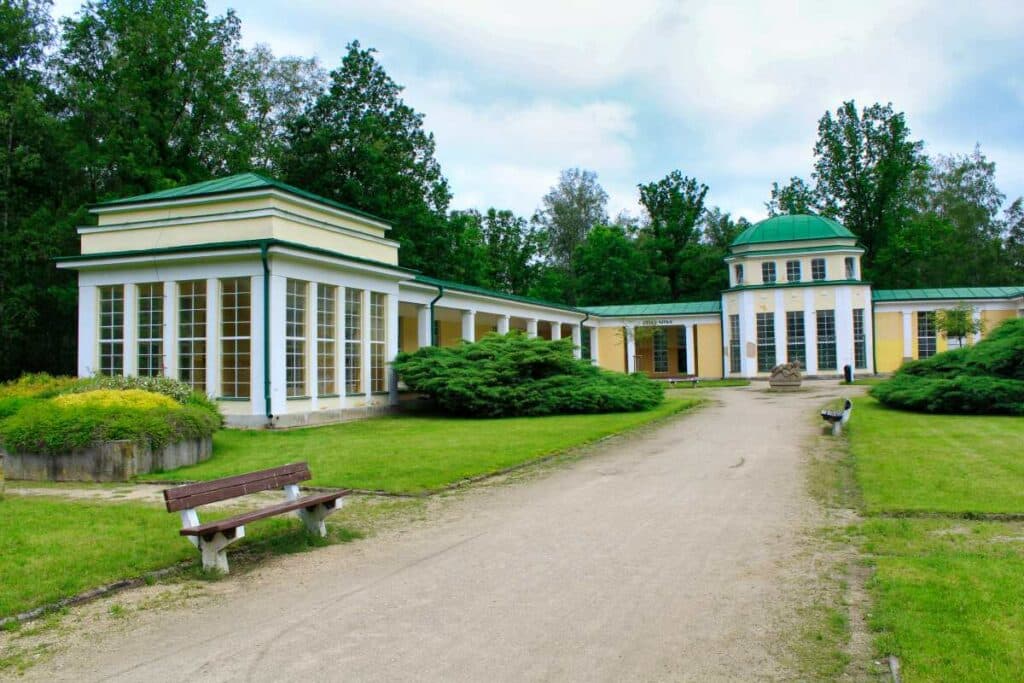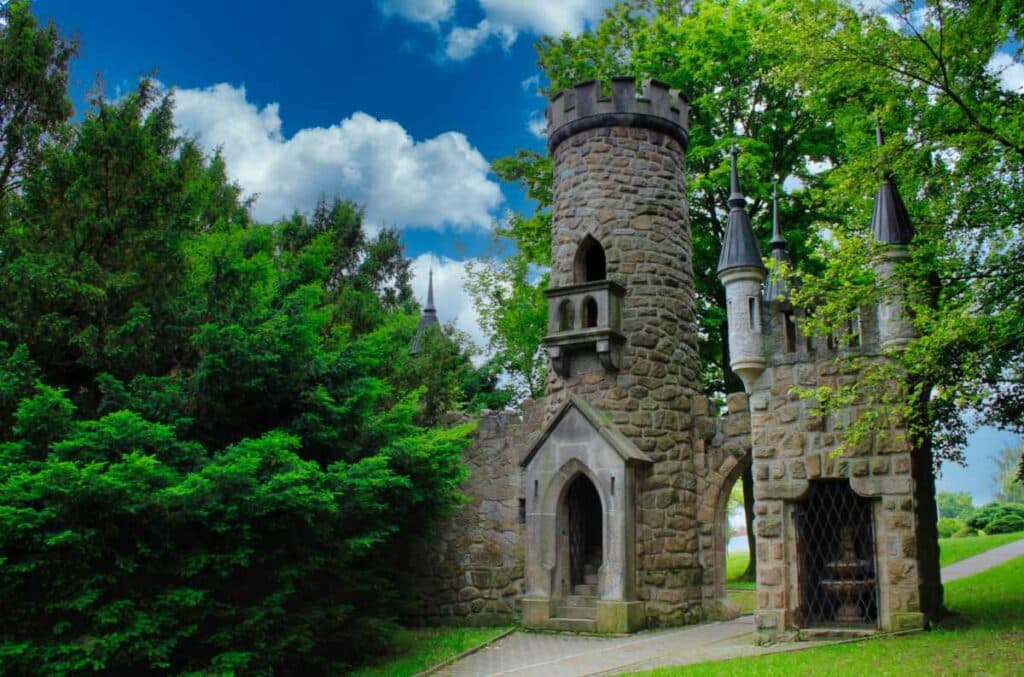Having already introduced you to Karlovy Vary and Jägerndorf in detail in our blog, our journey through West Bohemia continues today and we head to the outermost part of the country, where a very special spa town awaits you just over the German border. Franzensbad looks like an open-air museum and is much better known than its mere 5500 inhabitants would suggest. In the following, we would like to take a closer look at the most beautiful sights in Franzensbad and show you what the town has to offer despite its small size.
This is Františkovy Lázně
Only six kilometers separate Františkovy Lázně from the regional capital Cheb (Cheb), with which it has strong historical ties. Until the middle of the 19th century, Franzensbad was still part of Eger, where several healing springs were discovered in the 15th century.

The separation of Franzensbad from Eger saw the first upswing in spa tourism. Goethe, who visited the town more than thirty times, Emperor Franz I, Theodor Herzl, Prince Metternich, Beethoven, Johann Strauss, Franz Kafka, the last Austrian emperor, Charles I, and Václav Havel all appreciated the healing springs of the smallest of the Bohemian spas with just over 5,000 inhabitants. The town was often visited for a follow-up cure after longer stays in Karlovy Vary or Mariánské Lázně.
Despite its small size, the town has a total of 24 state-approved medicinal springs, all of which are significantly cooler than those in Karlovy Vary and were previously used not for drinking but only for bathing cures and are among the most exciting Franzensbad sights. In contrast to Mariánské Lázně and Karlovy Vary, it is also noticeably more tranquil and cozy here, making you feel “like visiting good friends”, as the Czech Tourist Office puts it.
Today, the small spa town is above all a paradise for strollers, with more than 250 hectares of parks shaping the image of the flat little town in the Eger basin. Incidentally, you can hardly get lost: the historic spa center comprises just five streets running parallel to each other from north to south, surrounded by a ring of parks. Due to the flat terrain and its proximity to Germany, the town is particularly popular with German senior citizens, who make up almost half of the guests.
But enough of the preface, you are surely already eager to discover the most beautiful Františkovy Lázně sights.

Glauber Springs Drinking Hall (Dvorana Glauberových pramenů)
We start in the Franzensbad spa district. In 1920, three new springs were discovered right in the center, the Church Spring and the Glauber III and IV springs. Ten years later, a wonderful oval Wandelhalle designed by Ernst Engelhart was completed. The four sgraffiti at the end of the hall symbolize Franzensbad’s development into a modern spa town and depict, among other things, the water bearers of Eger.
In 1791, they destroyed some of the facilities and dared to revolt when they saw themselves deprived of their business basis by the canalization of the springs. The middle spring is located below ground level and is said to have the highest carbon dioxide content of any spring in the world.
Social House (Společenský dům)
The social house in the style of classicism and neo-Renaissance was one of the first buildings in the city, the foundation stone was laid already at the end of the 18th century. It is one of the most beautiful buildings in Franzensbad and for decades was the most important social meeting place for illustrious spa guests, who dined, debated and held balls here. Today it is home to the wonderful Goethe restaurant, a café in the Viennese coffee house style and the former casino, which is no longer open.
New colonnade with gas bath (Nová kolonáda s Plynovými lázněmi)
Opposite the Gesellschaftshaus is another eye-catcher, the neoclassical New Colonnade designed by Gustav Wiedermann, one of Franzensbad’s most architecturally exciting sights. Today, the colonnade houses restaurants and stores, including an Oblaten, for which the region is so famous, and the charming Café Kolonada with Italian cuisine. Adjacent to the L-shaped colonnade is the gas bath, which is reserved for spa guests. Natural CO² is used for treatments here. The entrance to the gas bath is “guarded” by two sphinxes on the main street, which symbolize the town’s prosperity.

Church of the Raising of the Cross (Kostel Povýšení svatého Kříže)
The town’s Roman Catholic parish church celebrated its 200th anniversary in 2020. When Emperor Franz I, whose equestrian statue can be found right next door in the town park, visited the town at the time, he was informed of the lack of churches in Franzensbad. The emperor financed the construction from a state fund, although the actual costs were more than twice as high as initially planned. Exploding construction costs for public projects are therefore by no means just a phenomenon of our time …
The church is one of the few examples of Empire-style churches in the Czech Republic. Above the pretty yellow façade with its four columns rises the chic bell tower above the gable, in which concerts are still played on a 19th century organ (for dates, see announcements at the entrance). Inside, the paintings by Wilhelm Kander, who was commissioned to decorate the Chapel of the Holy Cross at Prague Castle in the mid-19th century, and the Baroque pews, some of which are still original, are particularly impressive.

City Park (Městské sady)
The city park to the north of the spa district offers a beautiful, rustic contrast to the often somewhat sterile-looking spa parks in the region. Although there are well-kept hedges here too, there are also interesting places such as a memorial in honor of the Czechoslovaks who died in the Second World War, an equestrian statue of Emperor Franz I in the south of the park and, next to it, the highlight of the park, a chic music pavilion where concerts are held throughout the season.

Olga Church (Kostel sv. Olgy)
Among the many beautiful buildings in the center, the church dedicated to St. Olga of Kiev, which belongs to the Orthodox Church of the Czech Republic and Slovakia, stands out. It was built between 1881 and 1889 under Gustav Wiedermann in the Neo-Byzantine style, making it the oldest Orthodox church in the Czech Republic. The construction was financed by donations, mainly from Russian spa guests. After the Second World War, many Orthodox Czechs came to the region from what is now western Ukraine, and some Orthodox Slovaks also moved here. To this day, their descendants make up the majority of the community.
The icons inside are donations from several Orthodox countries such as Russia and Greece, while the iconostasis dates back to 1975. An interesting detail: the religious feast days depicted above all fall within the course season. The iconostasis is in the style of the so-called Vosnetsov School, which is rarely used in Russia today. A few years ago, the church received relics of several saints through donations from the Sergiyev-Possad Monastery north of Moscow, which now rest in capsules in the large wooden cross in front of the iconostasis. Among other things, supposed body parts of St. Valentine and St. Ludmilla of Bohemia, the country’s first Christian ruler, can be admired here.
Imperial Spa (Císařské lázně)
The largest spa building in Franzensbad was built in 1880 in the neo-Renaissance style and was designed by Gustav Wiedermann and Karl Haberzettl. The St. Petersburg banker Singer financed one of the most beautiful sights in Franzensbad. The central atrium with its French-style dome and gallery is particularly magnificent. Concerts are still held here. Today, the spa with its around 120 treatment rooms is mainly used as a spa, for example for elaborate mud treatments.

Natalie Spring (Pramen Natálie)
In 1878, three springs were discovered in a wooded area to the east of the town center, which quickly became very popular due to their healing properties. When a Serbian princess named Natalie visited the spring two years later, it was promptly named after her. After an initial provisional superstructure, a wonderful imperial yellow colonnade was erected in the interwar period, which was visited for a long time due to its relative seclusion and the refreshingly cool 10 °C water. At that time, a second building boom began in the town. Tracks run not far from the spring, which are still used today to transport peat from the surrounding area to the town center, where it is then processed and transported to the Kaiserbad.

Lookout tower Salingburg (Rozhledna Salingburg)
To mark the 500th anniversary of the discovery of the local healing springs, Gustav Wiedermann built a neo-Gothic lookout tower on what was then a relatively unwooded hill on the edge of what was then Franz-Joseph-Park to the south-east of the city center. The result was a kind of mini fairytale castle, which today can be reached within a few minutes from the city center via a beautiful footpath. The small lookout tower is not only one of the most unusual sights in Franzensbad, but also offers a great opportunity to relax and a good view of the fallow deer enclosure below.

Forest Park America (Lesopark America)
Franzensbad is the closest European city to America, the locals like to joke. Southwest of the center is an idyllic wooded area with a 45-hectare lake and several surrounding ponds, which can be easily reached on a short hike from the center, by bike or by mini-train. Here you will not only find a unique bird reserve with a lookout pavilion, boat hire and the two highly recommended restaurants Chaloupka u Vody and Red Baron, but also a free mini zoo and playground. To the north of the lake is the small swan pond with some of the elegant animals.
Františkovy Lázně Book Tip
Did you like the sights of Franzensbad and would you like to take a trip to the Bohemian Spa Triangle yourself? Then my travel guide “CityTrip Bohemian Spa Triangle”, published by Reise Know-How Verlag, is just the thing for you. Here I describe not only a few more sights in Franzensbad, but also Karlovy Vary, Mariánské Lázně and Cheb in detail and not only present the sights, but also provide you with lots of practical tips for your trip to the Czech Republic.
No products found.
Hotel tips Františkovy Lázně
- Hotel Bohemia*, Klostermannova 92, on the outskirts of Františkovy Lázně, is one of the few non-spa hotels in the town and has a restaurant with Czech cuisine (homemade cakes), a wellness studio and a playground for children. Very good value for money.
- Imperial*Dr. Pohoreckého 3, where historic events once took place, for it was here that the future Emperor Charles, the last Austrian emperor, first met his future wife Zita. The outwardly perhaps the most beautiful hotel in the city offers, in addition to spa treatments, fitness, mini golf, its own parking lot, a restaurant and free admission to the attached Aquaforum.
- Pawlik*, 5. května 106. The huge complex on the edge of the spa district leaves nothing to be desired. In addition to countless rooms in various categories, it has its own water park, parking, a buffet restaurant, a wonderful lounge, a small forest area, a children’s playground, bicycle rental and a mini zoo. The spa hotel is deliberately not only aimed at older guests, but is also open to families. An underground tunnel leads to the Imperial Spa, which is run by the same company.
How did you like the article about the sights of Franzensbad? Which other Franzensbad sights do you know? Let us know and write us a comment!



